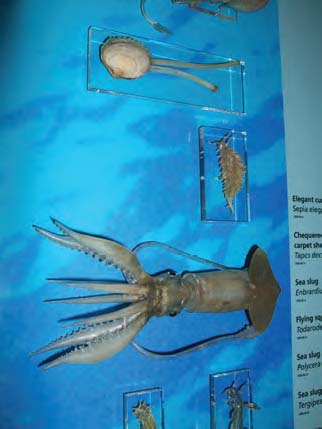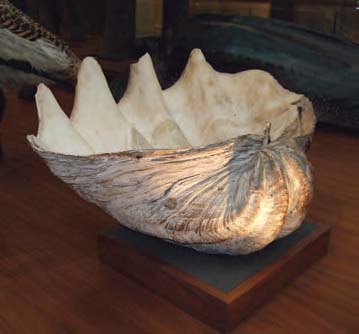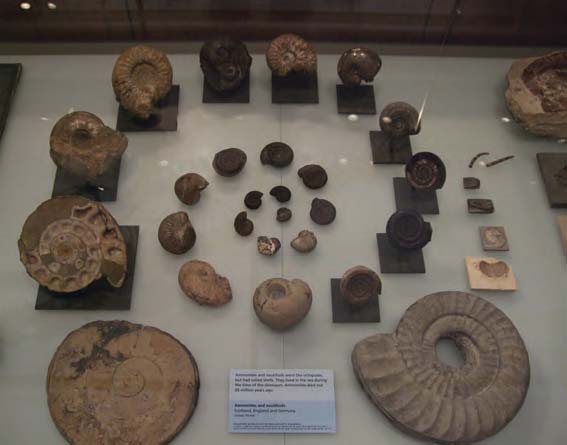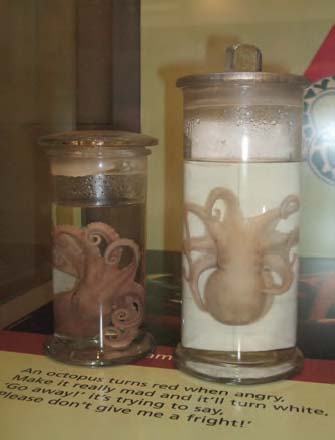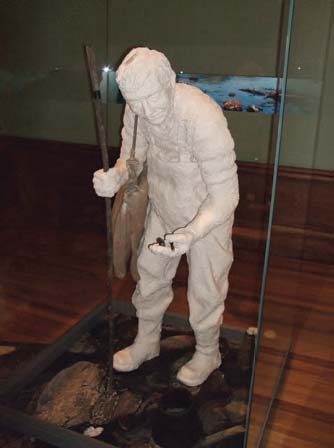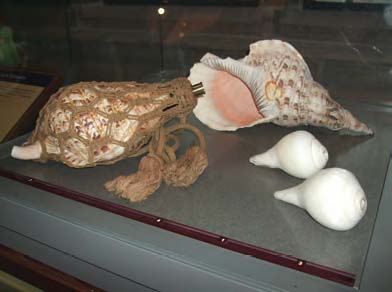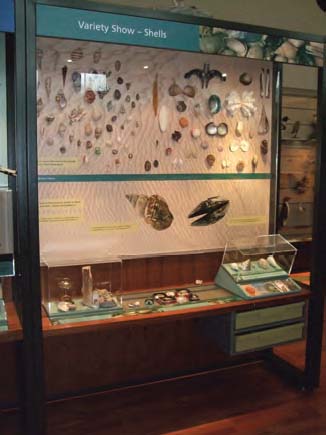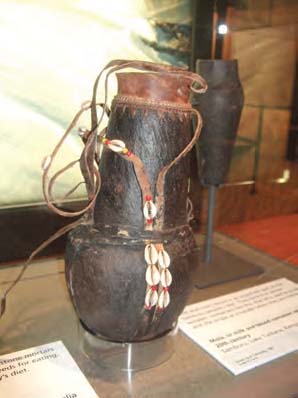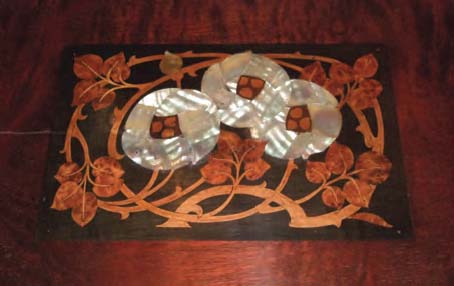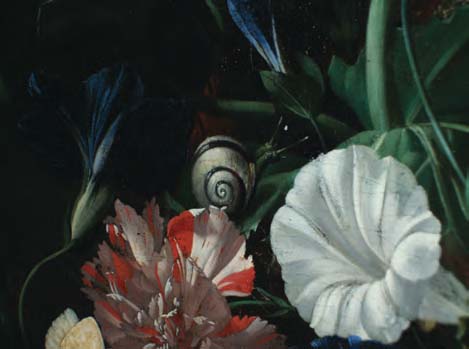Issue
17
Page
17
|
The Kelvingrove is the jewel in the crown of the art galleries and museums in Glasgow. In 2006 it reopened after a three-year refurbishment and has gone on to attract over 4 million visitors and become the most visited tourist attraction in Scotland.
The displays cover a wide variety of topics from French art to Scottish archaeology and from ancient Greek masks to Italian armour. Throughout the museum molluscs are present in a surprising number of places.
Obviously they are well represented in the natural history galleries. There are the common marine and freshwater shells on display in Life in Scottish Lochs, mainly just empty shells but there are also several beautiful glass models made by Blaschka of Dresden. These include a chequered carpet shell Tapes decussates (which has a real shell with glass ‘soft’ parts added), a sea slug Eubranchus pallidus and a flying squid Todarodes sagittatus (photo 1). In Nature’s Recordbreakers there are examples of our biggest shells with half of a giant clam Tridacna gigas (photo 2) and a trumpet shell Syrinx auranus and some of our smallest shells the dwarf snail Punctum pygmaeum and the pygmy pea mussel Pisidium Moitessierianum.
The plight of some endangered tree snails is shown in Wildlife in Danger with several Partula sp., a Euglandina rosea and an Achatina fulica all displayed alongside a cartoon story charting the tree snails demise. There is also a display about the effects of tourism on threatened species and how some species of mollusc are facing extinction because of over collecting; these include Manus Island tree snails Papustyla pulcherrima and queen conchs Strombus gigas.
Fossil molluscs are well covered in the Creatures from the Past gallery with a large display of ammonites (photo 3) as well as belemnites and prehistoric gastropods, bivalves and nautiloids all in displays called Life at the time of the Dinosaurs and Local Fossils.
In the display Animal Speak one of the cases contains some curled octopus Eledone cirrhosa (photo 4) in spirit, these are used to show how colour is used for communication. This story was aimed primarily at preschool children and simple rhymes were used as the main type of text so there is even a short poem about octopus in the display.
The Last Pearl Fishers in Scotland looks at the end of the freshwater pearl fishing industry and the people who used to make their living by searching for Margaritifera margaritifera in the rivers of Scotland. A life-size model of a fisherman helps show how the different bits of equipment were used (photo 5). This display also details the life cycle of the pearl mussel and shows how its decline was due to a variety of factors and not just fishing.
The Study Centre is an area where visitors can conduct further research into aspects of the collection with the help of computers and a small library. There are also small cases with mini displays of areas of the collection not covered elsewhere in the museum. In one case titled ‘What is Real?’ there are several models of shells next to examples of real shells. These include a carved wooden Conus gloriamaris and a papier-mâché Pleurotomaria. In another case there are chank shells Turbinella sp. and trumpet shells Charonia tritonis that have been turned into horns (photo 6). There are also several examples of different type specimens from the 1910 Thomas Gray collection and the 2002 Peter Dance collection.
The Environment Discovery Centre is a gallery aimed mainly at school groups where visitors can get a more hands on experience and can work closely with education assistants who run short tours and classes. There are shells in several areas including the seashore and invertebrate identification displays but the main feature is the Variety Shells display. This is a small snapshot of the huge diversity of molluscs and includes specimens in spirit, a sorting game, a naming game and drawers showing variety in colour and stages in growth (photo 7).
There are many examples of using shells for decoration amongst the ethnography collections. These include shells used for a pair of ancient Egyptian earrings, wedding bracelets from India made from chank shells, cowry shells as part of the decoration on a drinking gourd from the Samburu people from Kenya (photo 8) and a large necklace from Peru made from parts of Spondylus shells. There are money cowries scattered around the base of a cast bronze mask from Benin and giant clams carved into the base of the unique ceremonial ‘turtle posts’ from the Torres Straits. Other displays where shells can be seen include a cameo carved on a Cassis rufa shell in the Mini Museum; oysters, scallops and limpet shells all found in shell middens from the Mesolithic period in the Scotland’s First People gallery and scallop shells next to fluted armour in Animal Armouries. One of the more subtle areas where molluscs are present in many galleries is in the use of mother of pearl inlay in various objects. In the Mackintosh and the Glasgow Style gallery there are some items of furniture including a delicate card table with an inlay flower design (photo 9) and a chair with butterfly designs. There are several carved Maori figures in different galleries all with paua shell eyes and in the Last Pearl Fishers in Scotland display there is a section looking at the shells most commonly used for inlay as well as a few examples of inlaid objects. In Scottish Identity in Art there is a Jacobite snuff box with inlay and in the Hunting story there are several antique hunting muskets and rifles with very finely detailed characters made from mother of pearl (photo 10).
Throughout the museum there are many paintings depicting molluscs. In a typical example of a Dutch still life by Jan Davidsz de Heem there are several oysters adorning a breakfast table. In a more contemporary still life by David Horn there are various shells depicted including a cone shell, a cowry, a turban shell and a large conch as well as strings of pearls (photo 11).
In several paintings there are living slugs and snails depicted, such as an identifiable Arion sp. and a Cepaea sp. in ‘Fairy Raid’ by Noel Paton, a tiny yet perfectly formed snail in ‘An allegorical landscape’ by Jan Bruegel II, and another possible Cepaea sp. in ‘Flowers by a tree trunk’ by Rachel Ruysch (photo 12)
There are also many paintings where the people in them are wearing pearls, these include pearl necklaces in ‘Portrait of Frances’ by John Michael Wright, ‘A woman in a satin dress’ by Caspar Netscher, ‘Salome with the head of John the Baptist’ by Carlo Dolci and in one the museums most important paintings, ‘A Man in Armour’ by Rembrandt, the man in question is sporting a pearl earring.
In almost every gallery molluscs are represented in some way showing how ubiquitous shells and their products have become in the world around us. If any members happen to visit Glasgow please get in touch and I would be more than happy to show them around the molluscan treasures of Kelvingrove. |
Photograph 1
Photograph 2
Photograph 3
Photograph 4
Photograph 5
Photograph 6
Photograph 7
Photograph 8
Photograph 9
Photograph 10
Photograph 11
Photograph 12
|

